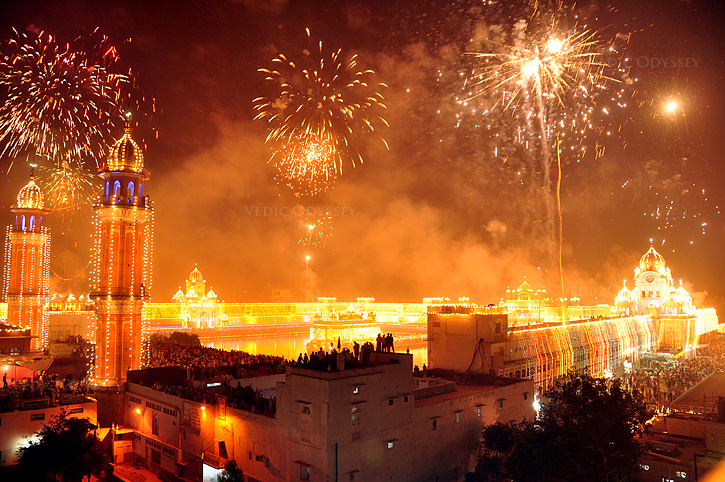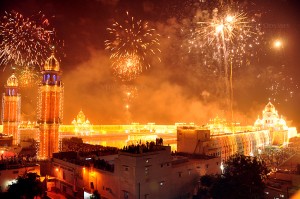Golden Temple in Amritsar is a place frequented by Sikhs all round the year. Countless pilgrims visit Golden Temple to pay homage to the holy shrine. Golden Temple is also known as Hari Mandir meaning Temple of God. The Temple has a tank (Sarovar) that is believed to possess healing powers. Sikh Gurus founded new centers for the promotion of Sikhism and these centers became popular as Sikh pilgrimage sites.
Distinguishing Features of Golden Temple
The construction of Golden Temple at a lower level was a break away from the Hindu tradition of constructing a temple at a higher level. It was done to make the visitors go down the steps in order to pay homage to the holy shrine.Other Hindu Temples have only one entry gate. The Golden Temple is open from all four sides symbolic of offering entry to all.
Interiors of Golden Temple
As Amritsar faced disturbances a lot of times, Golden Temple also became the target of loot and plunder thrice by the Afghan invaders. Maharaja Ranjit Singh donated Rupees Five Lakhs for placing for rebuilding Golden Temple and placing of gold plates on the outside walls. Mohammad Yar Khan Mistri was appointed as a technical expert for the task of gold plating. The architecture of Golden Temple is really remarkable achievement of Sikh architecture. The skill of the craftsmen is evident from the nakkashi (intricate carvings) and frescoes inside the temple.
History of Gurudwara
The origin of the place Amritsar is still mysterious in the history. There are several legends that explain the existence of the pool of nectar (also called Amrit Kund). The History of Gurudwara Golden Temple in Amritsar can be traced in following steps of its evolution.
Site of the Golden Temple
Originally the site of Golden Temple was a low-lying are filled with water in the centre (called Dukh bhanjani beri) and surrounded by a large number of shady trees in a jungle. The area formed a commercial link between India and Afghanistan, so it was visited by a number of traders. Still nobody talked about the pool before Sikh Gurus visited it.
Legends connected with the Sarovar (pool of nectar or tank)
Guru Amar Das Ji, third Guru of the Sikhs, discovered a herb to cure the ailment of Guru Angad Dev Ji, the second Guru of the Sikhs.
The story of Rajni, daughter of Rai Duni Chand has associations with Sarovar Sahib (tank). The story goes like this: Rajni was a devout Sikh disciple of the Guru. One day her father brought some gifts for all three daughters. Other two daughters praised their father. Rajni said that the gifts were from God and their father was only a medium to deliver the gifts to them. Unfortunately, her father overheard the statement and in a fit of anger, he ordered her to marry a leper. She accepted her father’s wish. She had to struggle hard to sustain herself and her crippled husband. One day she placed the basket containing her husband near the pool of nectar and went for some work. In the meantime, her husband saw a black crow plunging in the water and coming out transformed into white color. Stunningly he watched all this and crawled towards the pool to take a plunge. He became perfectly fine and handsome. The couple thanked God and went to their Guru to narrate the miraculous incident and seek his blessing.
Guru Ram Das Ji found the place during his travels in the Majha region. He chose this place for establishing a new Sikh centre. He was told by Guru Amar Das Ji to execute the plan for the construction of a Sikh Pilgrim Centre. Some experienced elders were told to assist Guru Ram Das. A large number of Sikh devotees came forward for voluntary service.
Construction Work
Some huts were constructed.
Excavation of the tank (Santokhsar) started. After completion of a part of the project, Bhai Jetha went to Goindwal to report regarding the progress of the work, he was told to dig another tank at the low level area near the site of the tank.Guru Ram Das Ji located the site for the second tank. It was amidst a large number of Ber (Jujube) trees. This tank came to be known as ‘Amrit Sarovar’.Along with the construction work, Guru Ji called a number of persons belonging to different tribes and occupations to settle near the tank. Like this a whole new village came up. There was a market to supply essential commodities to the settlers. For drinking water some wells were dug. Each and every care was taken to help the immigrants.Soon after the completion of the project, the pool of nectar and the Temple were recognized as places of religious importance. The project was executed under supervision of Guru Arjan Dev assisted by Baba Budha, Bhai Gurdas and some other prominent Sikhs.Guru Arjan Dev Ji compiled Guru Granth Sahib (holy book of Sikhs) and the original book was installed in the premises of the Temple.
 Amritsar Temples Photo Gallery, Famous Temple and Gurdwara Pictures, Information and History Amritsar Temples is the best place where you find beautiful collections of Amritsar Temple pictures, Info and history like golden temple, durgiana mandir, model town, mata lal devi mandir, shivala bagh bhayian and more. Amritsar Famous Temples, History, Information, About Historical Mandir, Golden Temple Pictures, Harmandir Sahib Gurdwara, Swarn Mandir, Darbar Sahib Amritsar, Durgiana Mandir Amritsar, Bada Hanuman Mandir Amritsar, Holy City Amritsar Pictures, Famous Amritsar Places, Shivala Bagh Bhayian Mandir,Bhadra Kali Mata Mandir, Chintpurni Mata Mandir, Ram Talai Mandir, Ram Tirath, Model Town, Mata Lal Devi Mandir, Shaheeda Sahib Gurdwara, Vaishno Devi Mata Bhawan Pictures, Radha Sawami Baba Ji Pictures, Veer Bhan Shivala, Gurdwara Chheharta Sahib, Sankat Mochan Hanuman Mandir, Gurdwara San Sahib, Banke Bihari Mandir, Gurdwara Goindwal Sahib, Baba Budha Sahib, Bohli Sahib, Itihasik Temples Pictures Download, Baba Bhoot Nath Maha Kaleshwar Mandir
Amritsar Temples Photo Gallery, Famous Temple and Gurdwara Pictures, Information and History Amritsar Temples is the best place where you find beautiful collections of Amritsar Temple pictures, Info and history like golden temple, durgiana mandir, model town, mata lal devi mandir, shivala bagh bhayian and more. Amritsar Famous Temples, History, Information, About Historical Mandir, Golden Temple Pictures, Harmandir Sahib Gurdwara, Swarn Mandir, Darbar Sahib Amritsar, Durgiana Mandir Amritsar, Bada Hanuman Mandir Amritsar, Holy City Amritsar Pictures, Famous Amritsar Places, Shivala Bagh Bhayian Mandir,Bhadra Kali Mata Mandir, Chintpurni Mata Mandir, Ram Talai Mandir, Ram Tirath, Model Town, Mata Lal Devi Mandir, Shaheeda Sahib Gurdwara, Vaishno Devi Mata Bhawan Pictures, Radha Sawami Baba Ji Pictures, Veer Bhan Shivala, Gurdwara Chheharta Sahib, Sankat Mochan Hanuman Mandir, Gurdwara San Sahib, Banke Bihari Mandir, Gurdwara Goindwal Sahib, Baba Budha Sahib, Bohli Sahib, Itihasik Temples Pictures Download, Baba Bhoot Nath Maha Kaleshwar Mandir

